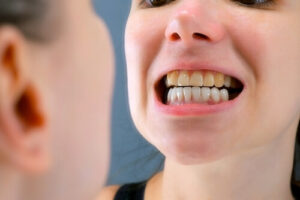In dental health, two common concerns often arise: tooth stains and cavities. While both can impact the appearance and health of our teeth, they differ in nature and consequences. Grasping the differences between tooth stains and cavities is crucial for keeping your smile healthy and bright.
This article seeks to understand the intricacies of tooth stains and cavities, highlighting their origins, how to prevent them, and available treatment options, thereby enabling individuals to make knowledgeable decisions regarding their oral health.
Introduction to Tooth Discoloration and Decay
Tooth discoloration and a cavity or tooth decay represent two prevalent dental concerns that, despite their differences, can significantly affect oral health and aesthetics. Tooth stains and cavities, while often confused, stem from distinct causes and have different implications for dental care.
Nature of Tooth Stains
Tooth stains, which can be extrinsic or intrinsic, arise from various factors, including consuming staining foods and drinks, tobacco use, along with poor oral hygiene. Extrinsic stains affect the tooth’s surface and are often removable with whitening treatments or professional dental cleanings.
Understanding Tooth Decay
Tooth decay, or cavities, occur due to the loss of tooth enamel caused by acids that are generated as plaque bacteria metabolize sugars in the mouth. Unlike stains that affect only the appearance of teeth, decay leads to structural damage and can cause tooth pain, sensitivity, and even more serious complications if left untreated.
Symptoms and Diagnosis
While tooth stains may present as discolorations on the tooth surface without affecting the tooth’s structure or causing pain, cavities are characterized by visible holes, pain, and sensitivity to hot or cold foods. A precise diagnosis from a dental professional is crucial for distinguishing between the two conditions and identifying the correct treatment approach.
Preventative Measures
Good oral hygiene prevents tooth stains and cavities by brushing with fluoride toothpaste, flossing, and limiting sugary and acidic foods. Consistent dental examinations and professional cleanings play a vital role in preserving oral health and detecting any emerging problems promptly.
Identifying Tooth Stains: Causes and Characteristics
Identifying tooth stains involves understanding their causes and characteristics, which are pivotal in determining the most effective treatment methods. Tooth stains can detract from one’s smile and confidence, but recognizing their origin is the first step towards teeth stains and restoring dental aesthetics.
Causes of Tooth Stains
Key factors leading to tooth stains encompass the consumption of specific foods and drinks (such as coffee, tea, wine, and certain fruits and vegetables), the use of tobacco, inadequate oral hygiene practices, and the natural aging process. These elements contribute to the formation of extrinsic stains on the tooth’s surface and intrinsic stains that lie deeper within the tooth, potentially caused by the use of certain medications, dental trauma, or various health conditions.
Characteristics of Extrinsic Stains
Extrinsic stains are usually yellow or brown and affect the surface of the teeth. They are often caused by dietary habits or smoking and can be removed through regular dental cleaning, toothpaste, and whitening strips.
Characteristics of Intrinsic Stains
Intrinsic stains occur within the tooth enamel and can be more challenging to treat. These stains might appear as gray, white, or even blue discolorations and are often the result of exposure to certain medications, dental fluorosis, or trauma to the entire tooth.
Prevention and Maintenance
Good oral hygiene practices, including brushing with fluoride toothpaste, flossing daily, and limiting intake of staining substances, can help prevent the formation of new stains. Routine dental examinations and professional cleanings are essential in keeping your smile free from stains.
Understanding Cavities: Signs and Symptoms

Understanding cavities, also known as tooth decay or caries, is fundamental to maintaining oral health. Cavities are caused by the erosion of tooth enamel, which occurs when acid from bacteria in plaque attacks the tooth, presenting a variety of signs and symptoms that signal the presence of this dental issue.
- Visible Holes or Pits in Teeth: One of the most unmistakable signs of a tooth cavity is a visible hole or pit on the entire tooth’s surface. These openings can vary in size and depth, depending on the severity of the decay.
- Toothache and Pain: A common symptom of cavities is a toothache or spontaneous tooth pain without apparent cause. The discomfort can intensify when eating or drinking, especially hot, cold, or sweet foods and beverages.
- Tooth Sensitivity to Temperature: Teeth affected by cavities often exhibit increased sensitivity to hot and cold temperatures, causing discomfort or sharp pain when consuming hot drinks, cold foods, or even inhaling cold air.
- Staining on the Tooth Surface: Cavities can also manifest as staining on the tooth surface, with discolorations appearing as white, black, or brown spots. These stains may initially be subtle but can become more pronounced as the decay progresses.
- Bad Breath or Taste: Chronic bad breath or an unpleasant taste in the mouth can signal the presence of cavities, particularly if associated with an infection resulting from tooth decay.
The Role of Oral Hygiene in Prevention
The pivotal role of oral hygiene in preventing dental issues such as cavities and tooth stains is well-documented. Maintaining a comprehensive oral hygiene routine is essential to remove the bacteria and plaque responsible for tooth decay and staining, thereby protecting the health and aesthetics of your teeth.
- Regular Brushing with Fluoride Toothpaste: Brushing your teeth at least twice a day with fluoride toothpaste is crucial for plaque removal and preventing the accumulation of tartar, which contributes to the development of cavities and tooth discoloration.
- Daily Flossing: Flossing daily is vital for eliminating food particles from areas between the teeth and beneath the gum line, where a toothbrush may not always reach, thereby lowering the risk of developing cavities and gum disease.
- Rinsing with an Antimicrobial Mouthwash: Using a mouthwash can provide additional protection by reducing plaque, preventing gingivitis, and freshening breath. Some mouthwashes also contain whitening agents to help prevent tooth stains.
- Limiting Sugary Foods and Beverages: Consuming fewer sugary and acidic foods and drinks can significantly lower the risk of developing cavities and enamel erosion, which are primary causes of cavities and tooth stains.
- Regular Dental Check-ups and Cleanings: Professional dental cleanings and examinations are vital for maintaining oral health, as they can catch and address issues early on, preventing more serious problems and removing surface stains that at-home brushing might miss.
Professional Diagnosis: Dentist’s Role in Identifying Stains vs. Cavities
The distinction between tooth stains and other cavities and stains is crucial for effective dental treatment, highlighting the indispensable role of professional diagnosis in dental care. Dentists are uniquely equipped to differentiate between these common dental issues, ensuring patients receive accurate assessments and appropriate treatments.
- Comprehensive Oral Examination: Dentists perform thorough oral examinations using specialized tools to inspect each tooth’s surface for signs of decay or staining. This detailed evaluation is essential for identifying the nature of the issue, whether it be a superficial stain or an underlying cavity.
- Dental Imaging Techniques: X-rays and other imaging techniques are often utilized to view beneath the tooth’s surface, providing a clear picture of any decay, cavities, or internal issues that cannot be seen with the naked eye. This technology is vital for accurate diagnosis and treatment planning.
- Expertise in Dental Conditions: Dentists’ extensive knowledge of various dental conditions allows them to distinguish between different types of stains (extrinsic vs. intrinsic) and identify the signs of cavities, including their severity and potential impact on oral health.
- Personalized Treatment Recommendations: Based on their diagnosis, dentists can recommend personalized treatment options. For stains, this might include professional cleaning, whitening treatments, or advice on avoiding stain-causing substances. Depending on the decay’s extent, cavity treatments could range from fillings to root canals.
- Preventive Guidance: Beyond identifying and treating current issues, dentists provide invaluable guidance on preventing future stains and cavities. This includes tailored advice on oral hygiene practices, dietary suggestions, and regular check-up schedules.
Treatment Options for Tooth Stains and Cavities

Treatment options to remove surface stains and cavities are tailored to address each condition’s specific nature and severity, underscoring the importance of personalized dental care. Effective management and treatment strategies to prevent cavities can restore oral health, enhance the appearance of the teeth, and prevent further dental issues.
- Professional Teeth Whitening: For extrinsic tooth stains, professional whitening treatments provided by a dentist can significantly lighten the color of the teeth, offering a more controlled and potent solution than over-the-counter products.
- Dental Veneers: For intrinsic stains or discolorations that cannot be corrected with whitening, dental veneers offer a cosmetic solution by covering the tooth’s front surface with a thin layer of porcelain or composite material, instantly improving the tooth’s appearance.
- Dental Fillings: Fillings are a common treatment for cavities resulting from tooth decay, involving the removal of decayed material and the subsequent filling of the cavity with dental substances like composite resin, amalgam, or other materials that match the color of the tooth.
- Root Canal Therapy: In cases where decay has reached the tooth’s pulp, root canal therapy may be necessary to remove the infected tissue, alleviate pain, and save the tooth from extraction.
- Crowns: For teeth that are extensively decayed or weakened, a crown may be recommended to cover and protect the tooth while restoring its function and appearance.
- Fluoride Treatments: Fluoride applications can help remineralize minor early decay areas and prevent the progression of cavities in some cases, serving as a preventive treatment alongside other dental care practices.
- Regular Dental Cleanings: Professional dental cleanings are crucial for removing plaque and tartar that contribute to tooth stains and cavities, serving as a treatment and preventive measure.
Maintaining Healthy Teeth: Tips for Prevention and Care
Maintaining healthy teeth is fundamental to overall well-being, requiring a proactive approach to prevention and care. Implementing effective oral hygiene practices and making informed lifestyle choices are key to preserving dental health, preventing tooth decay and stains, and ensuring a bright, healthy smile for years.
- Regular Brushing and Flossing: It’s crucial to brush at least twice a day with fluoride toothpaste and to floss daily to eliminate plaque, prevent the formation of cavities, and avoid tooth discoloration.
- Balanced Diet: Consuming a balanced diet rich in vitamins and minerals while limiting sugary and acidic foods and beverages supports oral health and reduces the risk of cavities and enamel erosion.
- Routine Dental Check-ups: Regular visits to the dentist for check-ups and professional cleanings are critical for detecting early signs of dental issues and removing tartar and surface stains.
- Use of Mouthwash: Incorporating an antimicrobial mouthwash can help reduce plaque, protect against gum disease, and freshen your breath.
- Staying Hydrated: Drinking plenty of water throughout the day promotes saliva production, which helps protect teeth from decay and washes away food particles and bacteria.
- Quitting Smoking: Avoiding tobacco products can significantly reduce the risk of tooth stains, gum disease, and other oral health issues.
- Protective Dental Wear: Using protective mouthguards during sports and avoiding using teeth as tools can prevent physical damage to teeth.
In summary, recognizing the distinction between tooth stains and cavities is essential for upholding effective oral hygiene practices. Tooth stains result from external factors like food and drink, while tooth enamel decay causes cavities. It is important to note that although tooth stains can be unsightly, they do not always indicate tooth decay or the need for dental treatment. On the other hand, cavities require immediate attention from a dentist to prevent further damage and potential tooth loss. By practicing regular brushing, flossing, and visiting the dentist regularly, you can effectively brush your teeth and prevent both tooth stains and cavities, ensuring a healthy and bright smile.
References
Cavity vs. Stain: Differences, Treatments, and Prevention
https://www.healthline.com/health/cavity-vs-stain
Cavity vs. Stain: An Easy Way to Distinguish Them
https://www.verywellhealth.com/cavity-vs-stain-7095978
Tetracycline and other tetracycline-derivative staining of the teeth and oral cavity
https://pubmed.ncbi.nlm.nih.gov/15485524/
Tooth Discoloration: Causes, Treatment & Prevention
https://my.clevelandclinic.org/health/symptoms/10958-tooth-discoloration
Cavities and tooth decay – Symptoms and causes of affected tooth. – Mayo Clinic
https://www.mayoclinic.org/diseases-conditions/cavities/symptoms-causes/syc-20352892

